Green Roofs: Integrating Blue and Gray
Drainage Layers
The next (and most important) material layer you need to understand in a green roof assembly is the drainage layer. We often see green roofs described in one of two ways:
- By soil depth (extensive, or shallow, with low-lying plants, versus intensive, or relatively deep, with bigger plants)
- By the assembly’s installation method (built-in-place or modular, tray-based systems)
Given that the primary function of a green roof is rainwater management, the means by which it drains and stores water are a more appropriate form of categorization. While the descriptors above are legitimate ways to characterize a green roof, they do not speak to its function.
The drainage system is the true backbone of green roofs. Drainage refers to the ability of a green roof assembly to move water not only downward but laterally across a roof during a heavy rain event. Green roof soil is engineered from natural materials, but it has very little organic content due to organic material’s propensity for decaying over time. Therefore, it does not hold water well. So this drainage layer seeks to capture and retain water during storms, keeping it available for access by plants and decreasing the volume of water pouring into storm drains in the process.
While we have covered the importance of rainwater management to some extent, it is worth noting that maintaining plants’ access to water is more challenging than you might think because green roofs tend to dry up quickly and unevenly. There are microclimates across many rooftops, wind along the outer edge of a building, shadows cast by bulkheads and other buildings, solar reflections from nearby windows, and “rain shadows” caused by nearby tall structures blocking rain can all cause differentials in soil moisture. Low-slope roofs typically have a 2 percent pitch, so water will travel toward and collect near drains. The result is too much water in some areas of the roof and not enough in others, making it advantageous to possess a mechanism not only for storing water, but for moving that water around.
There are four primary material types used in the drainage layer: molded drainage, entanglement sheets, granular material and structural drainage. In the next section, we will take a closer look at each.
1. Molded Drainage
These waffle-like, “cuspated” plastic drainage layer materials usually come in one of two forms: drainage plates (which are sold in semirigid sheets that are packaged flat and require a separate filter fabric to be used with them) and drainage mats (which are flexible composite materials packaged into rolls that include filter fabric on one or both sides).
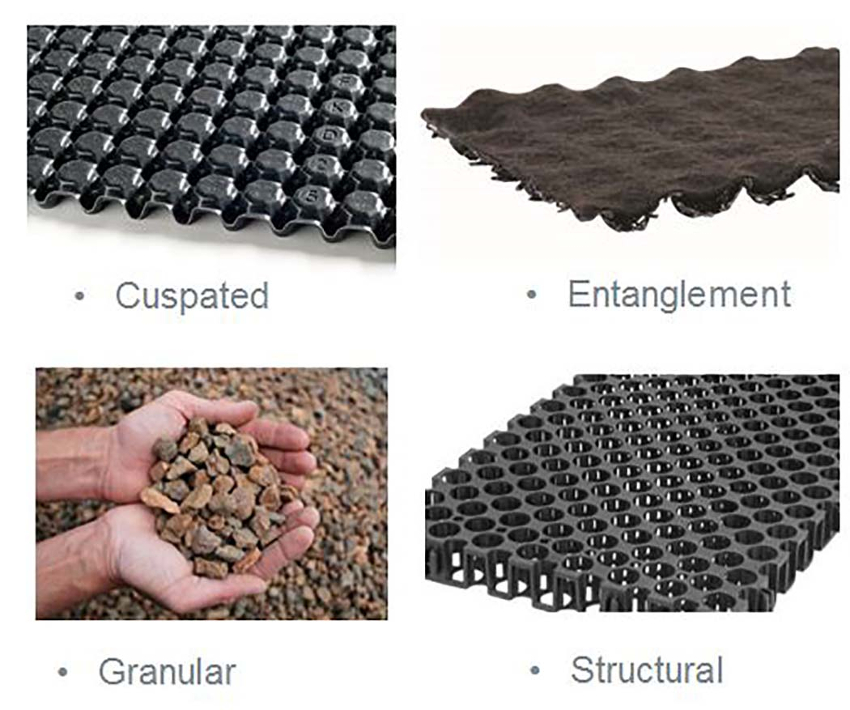
There are four main drainage material types used in green roof construction: cuspated sheets, entanglement sheets, granular material and structural drainage.
Drainage plates tend to be the better-performing option of the two, as they are three-dimensional on top and bottom. The cups on top act as miniature reservoirs during heavy rain events, as water flows through the soil layer, through the filter fabric and into the cuspated sheet. This serves as both a water management function and makes water available to plant roots. As it evaporates, the water will eventually travel back up into the soil layer. They are available in multiple heights for varying storage capacities and offer varying lateral flow rates depending on the width of channels between cups. The bigger the cup, the lower the lateral flow rate and vice versa.
Drainage plates have good “sheet flow,” or lateral flow of water toward drains because their geometries include channels by which excess water can easily travel toward drains without backing up. These plates can typically provide excellent drainage during heavy rains or when handling incoming runoff from other parts of the roof. Their design also ensures that there is always an air layer above the plate even during the heaviest storms, allowing plant roots to remain healthy.
Drain plates need to be overlapped during installation to create a monolithic drainage layer. In a perfect world with no thermal expansion and contraction, no building movement, no wind, no freeze/thaw cycle and no plant growth/change, it would not be necessary to nest drain plates on top of one another; but in reality, there are a number of physical forces constantly trying to push these materials apart. Any movement could result in soil movement down to the waterproofing membrane, potentially causing abrasion, erosion and drainage compromise. So, maintaining that monolithic drainage layer is paramount.
While drainage plates have many advantages, they tend to cost more than drainage mats; require more labor to install; and require a separate filter fabric—leading some contractors seeking to value-engineer a job to choose drainage mats instead.
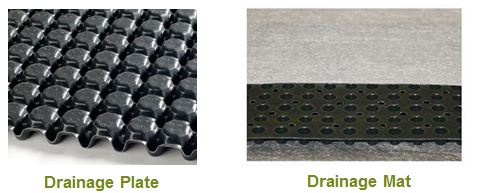
Cuspated sheets, or “molded drainage,” provide built-in storage for water via molded cups in the material. They are categorized into drainage plates and drainage mats.
Drainage mats are flat on the top with cups placed throughout the sheet. While these cups are capable of capturing water, once the drainage mat’s cups are full, water can only drain slowly through small holes interspersed between cups, exposing roots to standing water and cutting off their air supply during heavy rains. Ponding water atop the sheet will move laterally toward rooftop drains, but it will have a hard time doing so fluidly because of roots and soil presence above the drainage layer. This can lead to freeze/thaw issues during cold months, contributing to formation of ice blocks on the roof that expand and contract, causing thermal movement where it is unwanted. The result can be separation of roofing layers, allowing soil movement down to the waterproofing layer where it might cause abrasion and other problems.
While they offer strong sheet flow, molded drainage materials cannot move water in their cups across the roof by capillarity due to their hard, plastic composition. Water residing in cups is only available to soil and plants directly above or within a few inches of the cup and cannot be accessed by plants farther away.
2. Entanglement Drainage
The second category of drainage layer material is entanglement drainage. Entanglement sheets look like coarse steel wool (though they are made of plastic), and they offer fair to very good sheet flow, depending on loft and density of the entanglement. While molded drainage options outperform entanglement sheets in the category of sheet flow, entanglement drainage has some ability to move water via capillary action while molded drainage cannot—helping to mitigate the issue of soil moisture differentials across the rooftop.
Contractors tend to enjoy working with entanglement drainage because it rolls out readily and is easy to install. Building owners also love entanglement sheets because they are relatively inexpensive (though slightly more expensive than molded drainage materials). Entanglement drainage also offers better aeration below the root zone than molded drainage layers.
It is worth noting that entanglement sheets have little to no water storage capabilities unless combined with an integral or separate moisture-retention mat. Moisture-retention mats are thick, industrial-grade felt geotextiles that absorb water (as you might imagine), but many are also designed for maximum capillarity. These mats can vary in thickness, but all of them:
- Absorb water
- Move water by capillarity
- Can be stacked to increase water storage
- Offer protective qualities (puncture resistance, tensile strength)
- Can be optimized for ideal performance based on need
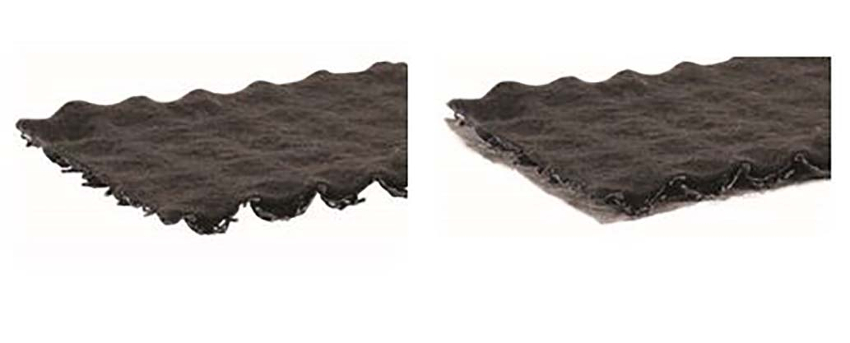
Entanglement drainage may not have the same level of sheet flow as molded drainage, but it is easier to install and offers some degree of capillarity.
3. Granular Drainage
Natural granular drainage material is comprised not of gravel, but of expanded shale granules that have been kilned to several thousand degrees Fahrenheit before “popping” like popcorn and expanding to 10–20 times their original size. The “popped” version of the shale is highly porous, allowing natural absorption of rainwater into the shale granules while also providing fair drainage. Granular drainage materials are capable of moving water via capillary action on their own, though they are typically paired with moisture-retention mats to hold water in place long enough to move it naturally from wetter lower levels of the roofing assembly to drier top levels. It also provides a strong environment for root growth.
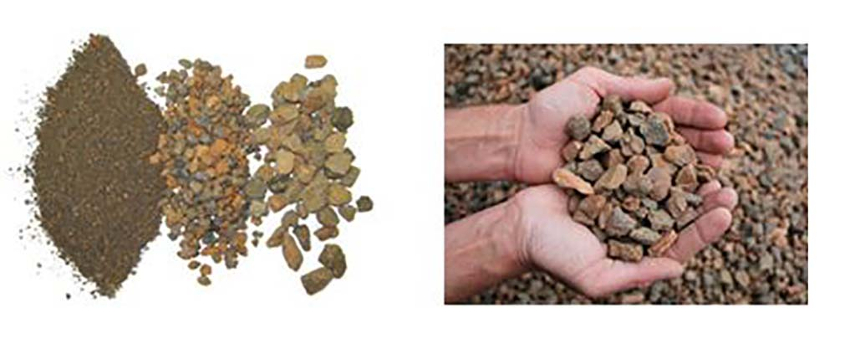
Granular drainage material is comprised of porous, expanded shale that can absorb water and provide a good growing environment for roots.
Because of the way this material absorbs water versus simply storing it like other materials, granular drainage cannot handle incoming runoff well. It also does not possess good sheet flow and tends not to drain rapidly. To help water flow where it needs to go, contractors will often install a slotted channel (or drainage conduit) in the granular drainage/capillary storage mat layer of a green roof assembly. During a heavy rain event, there will be a pressure differential between the water in the drainage media and the air in the slotted channel, so the water will shoot into the channel, through a network of drainage conduits and then be routed to a roof drain box. The conduits snap onto these porous roof drain boxes, which are located across the rooftop and allow water to flow off the roof while keeping debris out of drains.

Drainage conduits are arranged into networks that mitigate slow flow in granular drainage layers and direct water into roof drains.
Granular drainage media is typically applied on a rooftop from a giant bag that is generally suspended by a crane. It is slit open and moved around, pouring onto already-installed capillary mats, where it is spread around by an installation team. Once it is evenly spread, 2 or more inches of filter fabric are added on top of the drainage media, then soil/growing media and plants are added. The finished product might look something like Figure 6.
What makes Figure 6 a “blue roof” is its ability to store water across its entirety, mitigating rainwater runoff and providing a source of water for vegetation. Water is stored under the paved areas that is less prone to evaporation, due to being shielding from the sun, and can then be transferred through capillary mats into vegetated areas, acting as a reservoir for plant life. Benefits of this type of a granular drainage/capillary storage setup include a continuous drainage profile across the roof, great storage and strong soil/plant biology due to the availability of water. Drawbacks are that it cannot handle incoming runoff well, has a higher labor cost than some other methods (though material costs are similar) and there is more overburden to remove in the event of a leak.

Figure 6
On this green roof, granular drainage media is installed beneath the soil layer and filter fabric. Water can move from beneath the pavers to planted areas via capillary action.
Figure 7 shows another example of a granular drainage/capillary storage roof, though this one serves a slightly different purpose. Instead of pavers preserving the water supply, this green roof intercepts and detains some incoming runoff from a higher nonvegetated roofing section. The water comes down the downspouts on the left during storms, showcasing that green roofs can help control rainwater runoff even beyond their actual footprint.
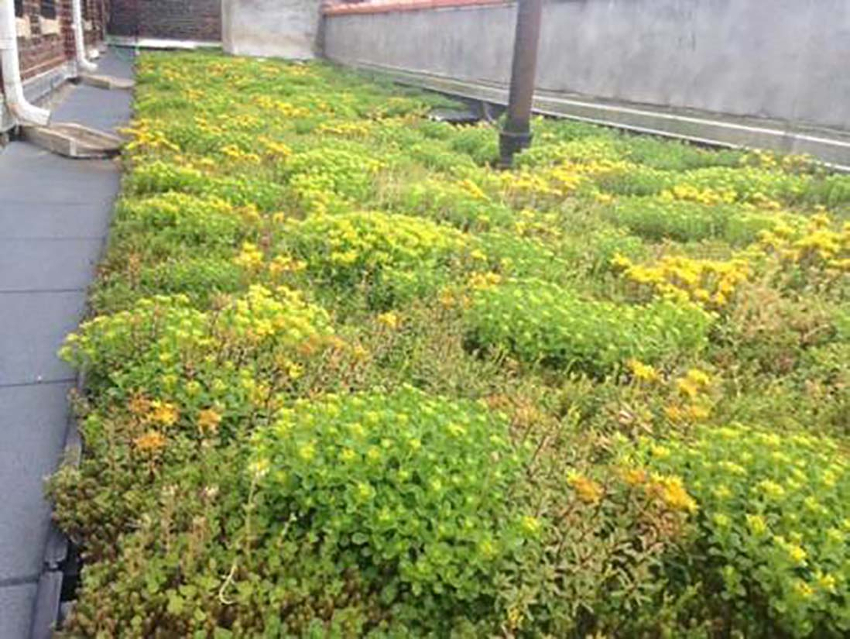
Figure 7
This granular drainage/capillary storage roof captures rainwater runoff from a higher, nonvegetated portion of the roof before it goes into a roof drain.
4. Structural Drainage
The fourth form of drainage is what one could call “structural drainage.” These heavy-duty constructions are typically built of hard plastic that bears loads while creating a void that water can fill and easily drain through. They may be honeycombed or resemble a plastic crate in design, and their key attribute is that they mostly consist of void space to provide excellent drainage characteristics while maintaining an air layer for plant roots.
Structural drainage constructions come in low-profile and high-profile variants. Low-profile versions, like the one on the left in Figure 8, cost less per square-foot than the high-profile version on the right, but the two options serve different purposes. The low-profile structural drainage material is designed specifically for easy drainage, providing little to no storage. The high-profile material may cost more per square-foot, but it is designed to provide substantial water storage. Therefore, it offers a lower cost per unit of storage volume.
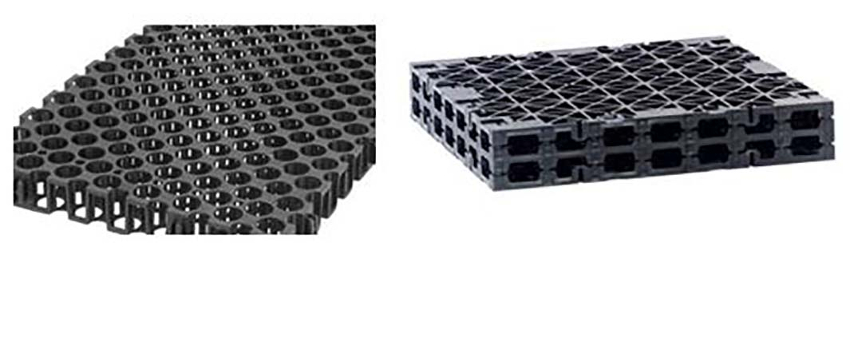
Figure 8
Structural drainage comes in low- and high-profile versions. The low-profile version costs less but is designed purely for drainage. The high-profile version stores significant amounts of water.
Structural drainage constructions provide a uniform footprint and are available in varying sizes and heights. For reference, the low-profile drainage material pictured is only 1-inch tall but provides great lateral water flow, whereas the high-profile version on the right in Figure 8 is more like 4 inches tall and can easily store 3 or more inches of water at a time. It can also be stacked to provide even greater water storage capabilities.
We often see this stacking occur closer to roof drains where water tends to pond and roofs slope downward. The structural height of the drainage media gradually increases closer to the drain, maintaining and leveling the growing bed on the surface of the green roof while providing necessary water storage near the drain. Figure 9 shows an example of this setup: the drainage media on the far right might be 3 inches deep while the media on the far left, near the drain, is more like 6 inches deep to suit the ponding depth in that area.
Ponding is a technique that can be used with both granular drainage assemblies and structural drainage assemblies. In either case, the whole green roofing assembly is situated on top of a ponding membrane that functions sort of like a bathtub. The ponding membrane fills with water, then some is stored in the drainage media and the rest is drained through a standpipe. As you can see in Figure 9, the area between the ponding membrane and the standpipe opening is submerged, allowing more water storage for plant access. The big difference between using granular media and structured drainage media for ponding is that granular media takes up a lot of room, holding perhaps only 25–35 percent of the drainage layer’s thickness in water, whereas structural drainage has so much void space that it can hold a depth of ponded water close to the depth of the actual drainage layer.
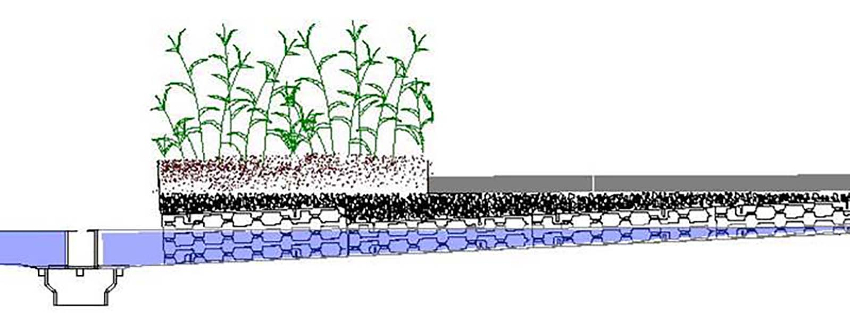
Figure 9
Structural drainage depths often gradually increase as they are installed closer to a roof drain to allow ponding of water and to maintain an even surface on a sloped roof.
Structured drainage can also be paired with pedestals that are designed to hold up concrete pavers on rooftops. Depending on height requirements of your weight-bearing materials under the pavement, structural drainage media or pedestals could prove to be the more cost-effective option for enabling ponding and maintaining the structural integrity of walkways. In either case, you will need some sort of drainage media in place. One thing to keep in mind is that construction of the sort of natural-looking, meandering pathway you see in Figure 6 is not possible with pedestals, as they require rectilinear, uniform pavement geometries to function properly.









